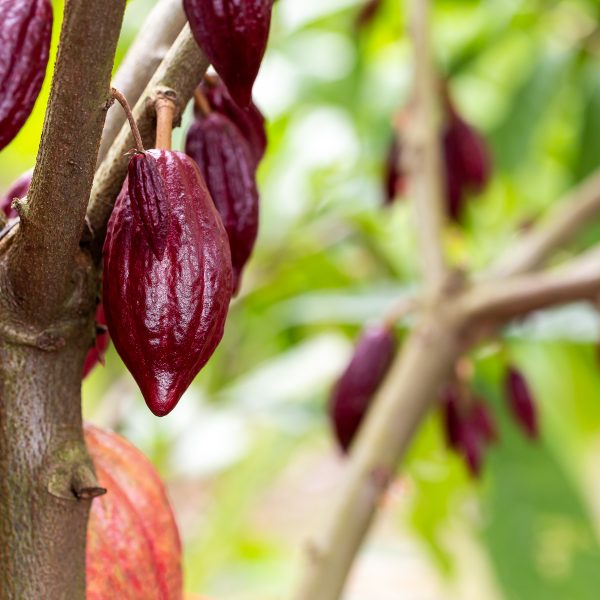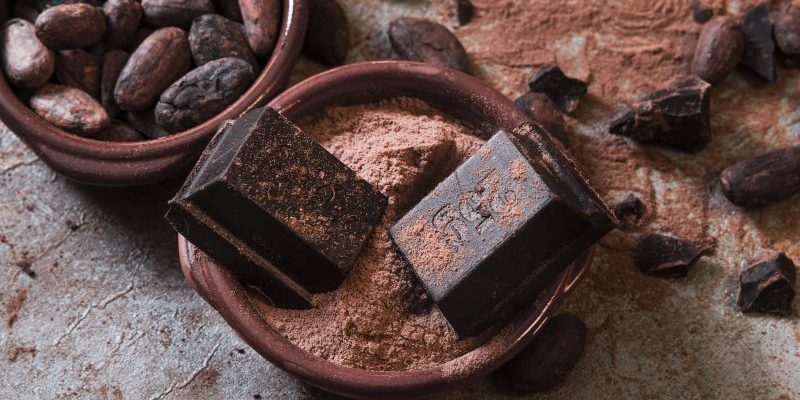People around the world consumed nearly 7.7 million tons of chocolate in the last year, but the cacao crop that supports the production of these sweets is under significant environmental threat. Millions of cacao farmers in West Africa, Southeast Asia and Latin America feel the pressures of ever-increasing consumption, a changing climate and devastating fungal infections. In 2017, The New York Times declared that we have entered “a battle to save the world’s favorite treat.”
Scientists at the HudsonAlpha Institute for Biotechnology with the help of Mars Wrigley Confectionery have created the newest weapon in that battle—an improved reference genome to help researchers and farmers develop healthier, more productive cacao crops.
Sweets Under Siege
The production of one of the world’s favorite delicacies relies on a particularly delicate plant. Cacao can only be grown within 20 degrees of the equator, and global studies suggest that the effects of climate change will shrink the farmland currently suitable for production even further. Increasing temperature and decreasing humidity in the areas that currently produce cacao will mean the crop must be grown at higher elevations.
Cacao also proves particularly vulnerable to fungi and diseases. It suffers from a number of menacingly-named blights, including frosty pod rot, witches’ broom, black pod and cacao swollen-shoot virus. One fear is that if any of these blights spread from its native region, it could sweep through global crops, devastating worldwide production.
The Newest Weapon in the War to Save Cacao
HudsonAlpha scientists have completed and released an updated reference genome for Theobroma cacao, the tree that produces cacao beans. With the help of funding from Mars Wrigley, HudsonAlpha researchers generated this new resource using advanced long-read sequencers, producing a more modern reference genome than the first version, which was completed in 2010.

A reference genome allows you to identify parts of the genome you wish to see carried through to the next generation of plants, like genes that promote drought tolerance, increase yield or improve disease resistance. Then, researchers can sequence each generation of selectively bred plants to quickly find which ones carry the desirable traits.
This most recent effort was was co-led by HudsonAlpha faculty investigators Jane Grimwood, PhD, and Jeremy Schmutz. Schmutz said of the project, “As our technology improves, we’re able to produce more detailed, versatile reference genomes, which are critical for the kind of rapid crop improvement you want to see with cacao.”
Farmers have used selective breeding to improve crops for centuries. The process works by crossbreeding two plants, hoping to combine desirable traits and make hardier plants. Then you take the offspring that show those traits and breed them again. This selective breeding process takes time though, as you have to wait for each crop to reach maturity. A cacao tree, for example, takes about five years to start generating fruit.
A Better “Chocolate Tree”
Cacao trees, like many modern crops, do not show a lot of genetic diversity. Most of the cacao trees worldwide come from a handful of clones selected in the 1940’s. Because the trees are so closely related, they have similar genetic weaknesses. If a disease reaches a group of cacao trees that doesn’t carry any genetic resistance to that disease, it can destroy the entire crop.

“Having so little genetic diversity leaves the cacao tree vulnerable,” noted HudsonAlpha Faculty
Investigator Jane Grimwood, PhD. “However, it also means that genes can be exchanged between trees, which gives researchers and farmers an opportunity.”
Using this new reference genome, researchers will be able to guide crossbreeding and hybridization efforts more quickly. That means traits like drought tolerance can be bred into a population faster and disease resistances can be introduced more efficiently.
The “chocolate tree” remains under threat, but now scientists and farmers alike have a more complete toolkit to produce more robust cacao crops.
About HudsonAlpha: HudsonAlpha Institute for Biotechnology is a nonprofit institute dedicated to developing and applying scientific advances to health, agriculture, learning, and commercialization. Opened in 2008, HudsonAlpha’s vision is to leverage the synergy between discovery, education, medicine, and economic development in genomic sciences to improve the human condition around the globe. The HudsonAlpha biotechnology campus consists of 152 acres nestled within Cummings Research Park, the nation’s second largest research park. The state-of-the-art facilities co-locate nonprofit scientific researchers with entrepreneurs and educators. HudsonAlpha has become a national and international leader in genetics and genomics research and biotech education and includes more than 30 diverse biotech companies on campus. To learn more about HudsonAlpha, visit hudsonalpha.org.
Media Contact:
Margetta Thomas
mthomas@hudsonalpha.org
256-327-0425


